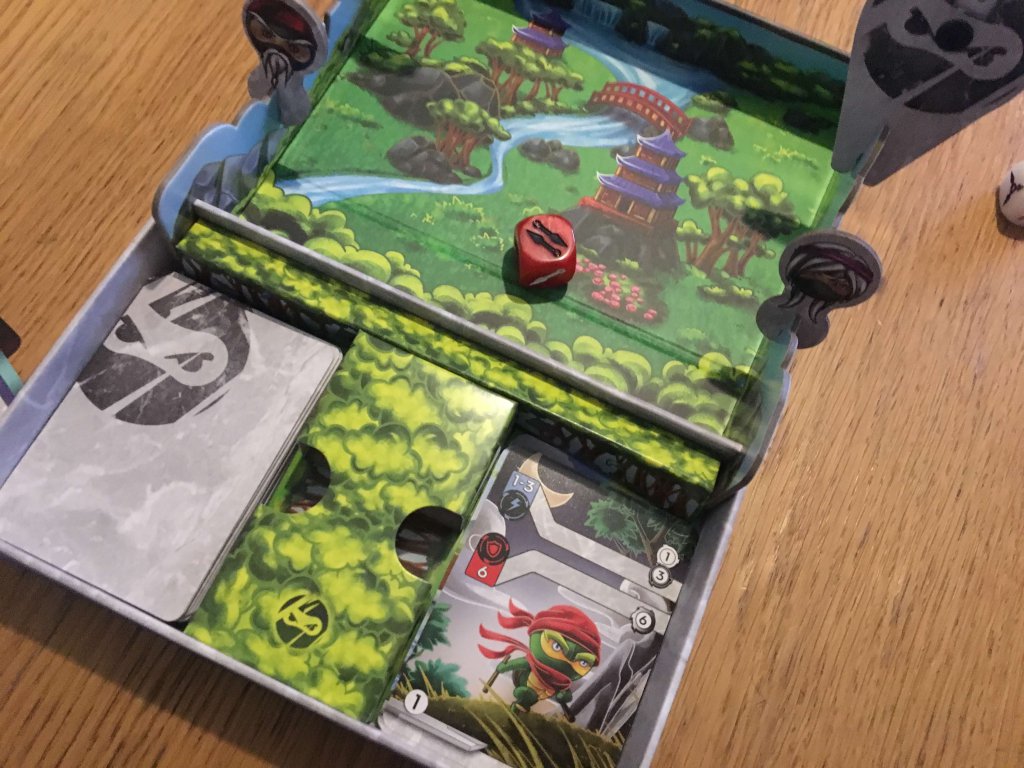In the high pressure market that is modern board gaming, boxes are becoming ever larger in an effort to grab the attention of ravenous gamers. Even portable or small games are often packaged in enormous, unnecessary packages that hog shelf space and oversell their contents. Not so with Tiny Ninjas, a portable game that uses its box as a safe, secure board to hold the components whilst in play.
Tiny Ninjas is a one or two player game that takes about fifteen minutes to play, in which the two sides will face off to determine who leads the most powerful ninja army. The game uses a smart mixture of hand management and card play — linking to a dice rolling system that encourages players to make decisions based on the risk versus reward for taking different actions. Whilst the game is over in short order, the decisions are meaningful and exciting.
In all honesty, Tiny Ninjas is one of the most unique designs that I’ve seen in a long while. The box has a magnetised lid that opens up and combined with a couple of push fit pieces of card to create two walled-off gardens. The imagery is concurrent across both sections inside the box, which makes Tiny Ninjas a beautiful thing to look at. Lay it out on a train or aeroplane and I promise, people will stop and ask questions about what you’re doing.
Inside the box, the players will find a surprising thick deck of cards, a couple of dice, various cardboard standee ninjas and a life counter that hooks onto each of the side panels of the box. I can’t say it enough — this use and reuse of the box, plus a few more pieces, just feels super efficient and very smart to me. If you travel often, want a game that is suitable for playing in the hotel, on the train or down at the pub, Tiny Ninjas fits the bill perfectly.
When the game itself begins, players will simply take turns to attack each other. Each player begins with five cards in hand and the attacking player will use one of them to kick things off. Each card has one or more attack possibilities, and sometimes special text, both of which will usually relate to the outcome of the dice rolled. Damage can be blocked by cards in the defending players hand, but successfully landed attacks will allow the attacking player to chain another card and attack again.
What this sort of boils down to is a “what if” system that challenges the attacker to balance the risk of pushing their luck both on the initial dice roll and then when a hit is landed, on whether they want to attack again. The real rub here is that the hand of five cards is used for both attack and defence (or defence and attack, depending on the turn order.)
With this in mind, a player may use all five of their attack cards consecutively and land five attacks, potentially defeating their opponent in the first turn. In doing so though, they will have no cards to defend with, should they not be able to finish the job. This will almost certainly lead to their opponent landing a heavy, if not fatal blow in retaliation. With only ten hit points going into each game, players can easily be eliminated in two or three turns at most.
The way combat works in Tiny Ninjas is based on a symbol driven system, with certain symbols denoting which dice should be rolled for what benefit. Some cards are all or nothing, offering big damage with a high chance of a miss. Others tow the line, allowing players to chain hits with reasonable levels of regularity. Luck of the draw and of the dice play their role, but given the ten to fifteen minute game time, it isn’t too big a beating to feel that you lost due to bad luck.
With superb components and a very high standard of finish, Tiny Ninjas cuts a very attractive proposition for payers prone to travelling, but it’s also not a bad filler or opening game for any static game night. The gameplay is luck based, but nonetheless offers a lot of decisions for a game of this style and weight. The deck of cards that drives it is large and diverse. Add factors like specific sensei powers into the mix and you have a high degree of replay value.
Players who demand strict control over every feature of a game might be frustrated with the luck elements and of course, Tiny Ninjas is strictly a one or two player game, so it doesn’t adapt well to travelling in a pack. That said, for the component quality, cost of entry and very solid, diverse mechanics, I’d say Tiny Ninjas is a success — certainly if you’re interested in portable or lighter options.
Tiny Ninjas is available to purchase now. You can find out more about it on the official website.




